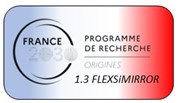Adaptative Optics (AO) requires fast and precise wavefront control using deformable optical surface (DM) with a large number of actuators. Current commercial DM technologies are efficient but still suffer from limitations in their temporal bandwidth, dynamical range, size, number of actuators, fragility/fatigue, and non-linear effects that need to be overcome for future instruments. Moreover, these DMs have unperfect shape at rest and are costly. We aim to develop a new hybrid high-speed, lightweight, large and low-cost deformable-mirror technology. This will lead to new cost-effective and lightweight opto-electronic systems that will be game changing for exoplanets studies with the ELTs. We hope to deliver a 30cm DM prototype made of a 3D printed array of electroactive polymers (EAP) actuators on the back side of a silicon membrane. It will be scalable to 50cm-class compact and lightweight (>1000 actuators) optoelectronic DM systems.



